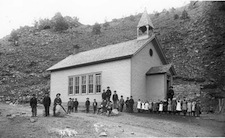It’s the time of year for saving money!
 Saturday night I went back to school. Sometimes I think I’ve never left. But this particular school was in the middle of the Colorado woods, by a mountain stream, about two miles from my house in the “burn zone” of Four Mile Canyon.
Saturday night I went back to school. Sometimes I think I’ve never left. But this particular school was in the middle of the Colorado woods, by a mountain stream, about two miles from my house in the “burn zone” of Four Mile Canyon.
The Salina Schoolhouse was built in 1874 by prospectors from Kansas. Last year when local firefighters had enough water to save either the fire station (with an engine stuck inside) or the schoolhouse, they chose the schoolhouse. The fire station burned to the ground.
While it wasn’t nearly as perilous on Saturday night, the Deadly Gentlemen make some seriously dangerous music in that it upsets what most people would consider “Bluegrass.” Actually they’re more like Doc Boggs meets the Beastie Boys. At times cacophonous, other times mellifluous with three part-part harmonies, the band is made up of five members – Greg Liszt on banjo, Stash Wyslouch on guitar, Mike Barnett on fiddle, Dominick Leslie on mandolin and Sam Grisman on acoustic bass. Liszt is also in the group Crooked Still, Barnett’s first pro gig was with Jessie McReynolds and he currently plays with David Grisman’s quintet, Leslie is a student at Berklee School of Music in Boston, Wyslouch used to play heavy metal, and Grisman is the son of the Dawg, David Grisman.
I’ve recorded in the Salina Schoolhouse before. It ain’t exactly Carnegie Hall. Rectangular, with little in the way of sound absorption, it can be charitably called “bonky” with a tendency to overload easily. The only way to deal with it is to get the microphones as close to the group as possible without losing anyone at the edge of the pick-up pattern.
For the live concert I wanted to go with an extremely minimalist recording rig. I used a pair of Alesis GT-40 microphones with their cardioid capsules connected via100 ft. run of Audio Magic microphone cable to a Korg MR-1000 DSD recorder. I monitored with my Ultimate Ears Reference Monitors. Everything fit into two smallish bags and took less than fifteen minutes to set up.
Although I had tested the Korg’s built-in microphone preamps, I’d never used them for a field recording. I was delighted to find they had so much gain that I could use the “low” gain setting on the recorder and never had to turn up the mic level past 9 o’clock. The dynamic range between the band’s quietest passage and their loudest one was over 26 dB, which approaches the range I often see on my classical recordings. I managed to record two whole sets with only one brief incidence of clipping.
What’s going to happen to the recording? I’ll give the Gentlemen a CD copy and if they want I’ll send them a 96/24, 192/24, or even a native DSD version of the show. I love recording in DSD because I can create a digital copy at virtually any bit rate and depth. Audiogate, which used to be only for Korg owners, but now can be used by anyone, is a great barebones editor, sequencer, and format convertor.
I’ll probably bring a high rez version of the recording to Rocky Mountain Audio Fest, so if you want to hear a remarkably open, uncompressed recording of what an acoustic group really sounds like live, Follow me to an exhibitor’s room and I’ll play it for you.





